Description
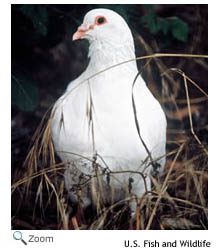 The rock pigeon is 11-13 inches in length with a wingspan of
20-26 inches. It is a plump bird with a rounded tail, pointed wings, and small
red to pink to grayish-black
legs and feet. It has round eyes surrounded by a rings of skin and a small bill with
a cere or fleshy covering on the upper part of its bill.
In the wild, the rock pigeon has a bluish-gray body, pale gray wings with two black bars, and a white rump. The rock pigeon is 11-13 inches in length with a wingspan of
20-26 inches. It is a plump bird with a rounded tail, pointed wings, and small
red to pink to grayish-black
legs and feet. It has round eyes surrounded by a rings of skin and a small bill with
a cere or fleshy covering on the upper part of its bill.
In the wild, the rock pigeon has a bluish-gray body, pale gray wings with two black bars, and a white rump.
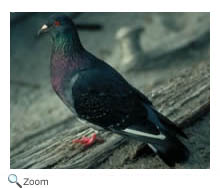 Rock pigeons found in cities can come in a wide variety of colors, from bluish-gray, pure white to brown. The wide variety of colors found in rock pigeons occurs because people have bred rock pigeons. Males and females look alike, but males are a little larger.
The rock pigeon is also known as the rock dove and the pigeon. Rock pigeons found in cities can come in a wide variety of colors, from bluish-gray, pure white to brown. The wide variety of colors found in rock pigeons occurs because people have bred rock pigeons. Males and females look alike, but males are a little larger.
The rock pigeon is also known as the rock dove and the pigeon.
Range
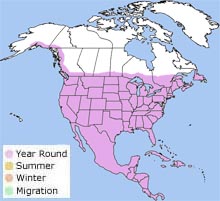 The rock pigeon is found from southern Canada and Alaska south through the United States, Mexico, and Central America. The rock pigeon is native to
Europe, North Africa, and southwestern Asia.
In the 17th-century, colonists brought the rock pigeon to Atlantic Coast settlements in North America. The rock pigeon is found from southern Canada and Alaska south through the United States, Mexico, and Central America. The rock pigeon is native to
Europe, North Africa, and southwestern Asia.
In the 17th-century, colonists brought the rock pigeon to Atlantic Coast settlements in North America.
Habitat
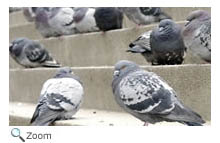 The rock pigeon is found in
variety of habitats including
rocky cliffs, farm land, parks, gardens, cities, and suburbs.
Humans have trained rock pigeons as homing pigeons. Homing pigeons can find their way home from long distances. Rock pigeons that are not trained usually don't wander far from their territory! The rock pigeon is found in
variety of habitats including
rocky cliffs, farm land, parks, gardens, cities, and suburbs.
Humans have trained rock pigeons as homing pigeons. Homing pigeons can find their way home from long distances. Rock pigeons that are not trained usually don't wander far from their territory!
|
|
Diet
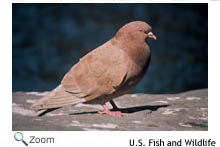 The rock pigeon
eats a wide variety of seeds. It may also eat
some insects and plants. In cities, rock pigeons eat seeds, peanuts, french fries, popcorn and a variety of handouts from humans.
The rock pigeon feeds on the ground in groups. The rock pigeon
eats a wide variety of seeds. It may also eat
some insects and plants. In cities, rock pigeons eat seeds, peanuts, french fries, popcorn and a variety of handouts from humans.
The rock pigeon feeds on the ground in groups.
Life Cycle
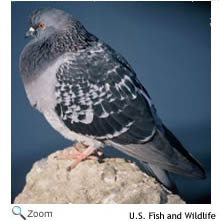 The female rock pigeon lays 2 eggs in a nest lined with sticks,
leaves, stems, roots, and debris. In the wild, the nest is built on a cliff. In cities and towns, the nest is placed on window ledges, on roofs, in traffic lights, and under bridges. The female rock pigeon lays 2 eggs in a nest lined with sticks,
leaves, stems, roots, and debris. In the wild, the nest is built on a cliff. In cities and towns, the nest is placed on window ledges, on roofs, in traffic lights, and under bridges.
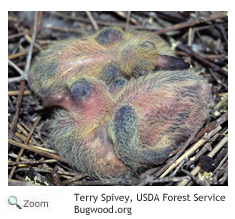 The male builds the nest.
Both the male and the female incubate the eggs for 19 days. Both parents feed the chicks or squabs "pigeon milk." Pigeon milk is a
a mixture of water, fat, minerals and protein that the male and female rock pigeon produce in their crop. Their crop is a
sac at the bottom of their esophagus.
Pigeon milk is also called crop milk. The chicks fledge when they they are
25-26 days
old. The female may have as many as 5 broods a year. Male and female rock pigeons may mate for more than one season and often use the same nest for many years. The male builds the nest.
Both the male and the female incubate the eggs for 19 days. Both parents feed the chicks or squabs "pigeon milk." Pigeon milk is a
a mixture of water, fat, minerals and protein that the male and female rock pigeon produce in their crop. Their crop is a
sac at the bottom of their esophagus.
Pigeon milk is also called crop milk. The chicks fledge when they they are
25-26 days
old. The female may have as many as 5 broods a year. Male and female rock pigeons may mate for more than one season and often use the same nest for many years.
Behavior
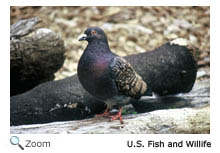 The rock pigeon and other birds in the Columbidae family have a unique way of drinking water. Most birds take a sip of water and then throw back their heads to swallow. The rock pigeon uses its bill like a straw to suck up water! The rock pigeon and other birds in the Columbidae family have a unique way of drinking water. Most birds take a sip of water and then throw back their heads to swallow. The rock pigeon uses its bill like a straw to suck up water!
|




 The rock pigeon is found from southern Canada and Alaska south through the United States, Mexico, and Central America. The rock pigeon is native to
Europe, North Africa, and southwestern Asia.
In the 17th-century, colonists brought the rock pigeon to Atlantic Coast settlements in North America.
The rock pigeon is found from southern Canada and Alaska south through the United States, Mexico, and Central America. The rock pigeon is native to
Europe, North Africa, and southwestern Asia.
In the 17th-century, colonists brought the rock pigeon to Atlantic Coast settlements in North America. 



